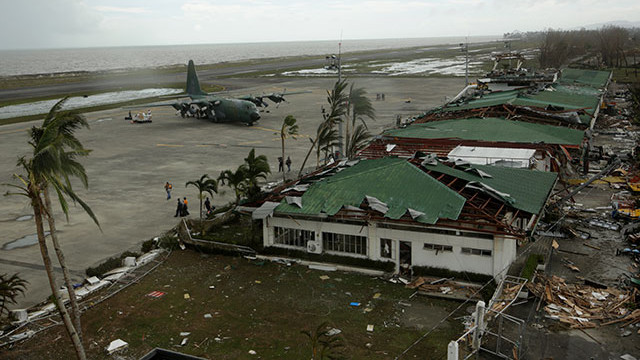SUMMARY
This is AI generated summarization, which may have errors. For context, always refer to the full article.

MANILA, Philippines – As the government begins the long and tedious task of rebuilding areas hardest hit by Super Typhoon Yolanda (Haiyan), it is looking to focus on first rebuilding the economic hub.
In the past, that was Tacloban. But now, the government is not so sure, said Presidential Assistant for Rehabilitation and Recovery Panfilo “Ping” Lacson.
“We are actually coordinating closely with [the private sector] to prioritize Tacloban or if we really have no plans to rebuild Tacloban, let’s look for another place that can be a hub of business activity like Palo [in Leyte],” Lacson said on Monday, January 27.
“Because maybe the path of future calamities really crosses Tacloban. So that’s being studied too. That’s why there’s a forum of experts looking at the movement of storms. Maybe Tacloban isn’t tenable anymore to be rebuilt in the manner it was before Yolanda,” he said. (READ: Climate change threatens economy of 4 cities)
Tacloban’s location on the country’s eastern seaboard exposes it to many climate risks, like tropical cyclones during the southwest monsoon.
From a range of 1 to 10 – with 10 being most vulnerable – Tacloban was rated 6.74 in terms of how exposed it is to climate change impacts, like stronger storms, extreme droughts, sea level rise, and aggravated flooding and landslides, based on a study.
The study, conducted by Worldwide Fund for Nature (WWF) Philippines and BPI Foundation, gave this score based on 3 factors: climate or environmental exposure, socio-economic sensitivity, and capacity to adapt. (READ: Tacloban: In the jaws of a ‘climate sandwich’)
Lacson said experts are also discussing whether the Tacloban airport, which was completely destroyed by Yolanda, should be transferred as well.
But Lacson clarified this does not mean Tacloban will cease to exist.
“It doesn’t mean that Tacloban will just be erased from the map of the Philippines. Right now, the rehabilitation by the United Nations Development Programme (UNDP) is continuous,” he said.
Tacloban was the hardest hit by Yolanda, also known as the world’s strongest typhoon. Yolanda made landfall in Eastern Visayas on Nov 8, 2013, killing over 6,000 people and leaving almost 2,000 others missing, according to the National Disaster Risk Reduction and Management Council.
This made the storm, which also left 4.4 million people homeless, one of the deadliest natural disasters in Philippine history.
Corpse retrieval continues
Lacson said the cleaning up of debris continues, with the UNDP having deployed 82 dump trucks to help with operations. Corpses, he said, also continue to be retrieved almost 3 months later.
“Last Friday they were able to retrieve 6 bodies (in Tacloban),” Lacson said.
He said this is not alarming, however, because it happens around the world where calamities of this magnitude strike. Lacson compared Yolanda to what happened in Banda Aceh, Indonesia, where a tsunami struck in 2004 left about 170,000 Indonesians dead.
“It is really possible (that corpses continue to surface) because of the magnitude, the intensity of the storm surge. That’s why you really can’t stop counting the dead or say, ‘Okay, we’ve reached 6,500, let’s stop counting,'” he said.
Lacson expects the death toll to continue to rise, saying the government “can never really close the count of fatalities” because “you don’t know when you will recover a new dead body.”
“You’ll never know because there’s a ship docked in a subdivision. We don’t know if there are bodies that were squished underneath. Thing like that. Others were washed away. Other corpses could have been swept to other islands. While still others in far-off place have been buried by their relatives who could no longer wait for the government,” he said.
Lacson added, “Don’t think that we are inefficient because that is really the norm in calamities.”
No presidential aspirations
Since his appointment, Lacson said he has begun to realize the difficulty of the task, joking he aged 6 years in the past 6 weeks.
He reiterated the need for a separate office that would integrate both the rehabilitation component and the disaster relief component. (READ: Lacson: Weak powers make rehab harder)
“It’s a way of life in the Philippines… The fact of life is, we will be hit by calamities at least 20 times a year of varying magnitude. So we might as well have an institution that will take care or focus on dealing with rehabilitation and recovery,” he said.
Lacson said he would recommend that a Cabinet Secretary post be created in the future, that would focus solely on disaster recovery and rehabilitation.
He also scoffed at critics who questioned whether his current role is in preparation for his 2016 political plans.
“I have no presidential aspirations. I have no pretentions. I am focused on my job. What you see is what you get,” he said. – Rappler.com
Add a comment
How does this make you feel?





There are no comments yet. Add your comment to start the conversation.